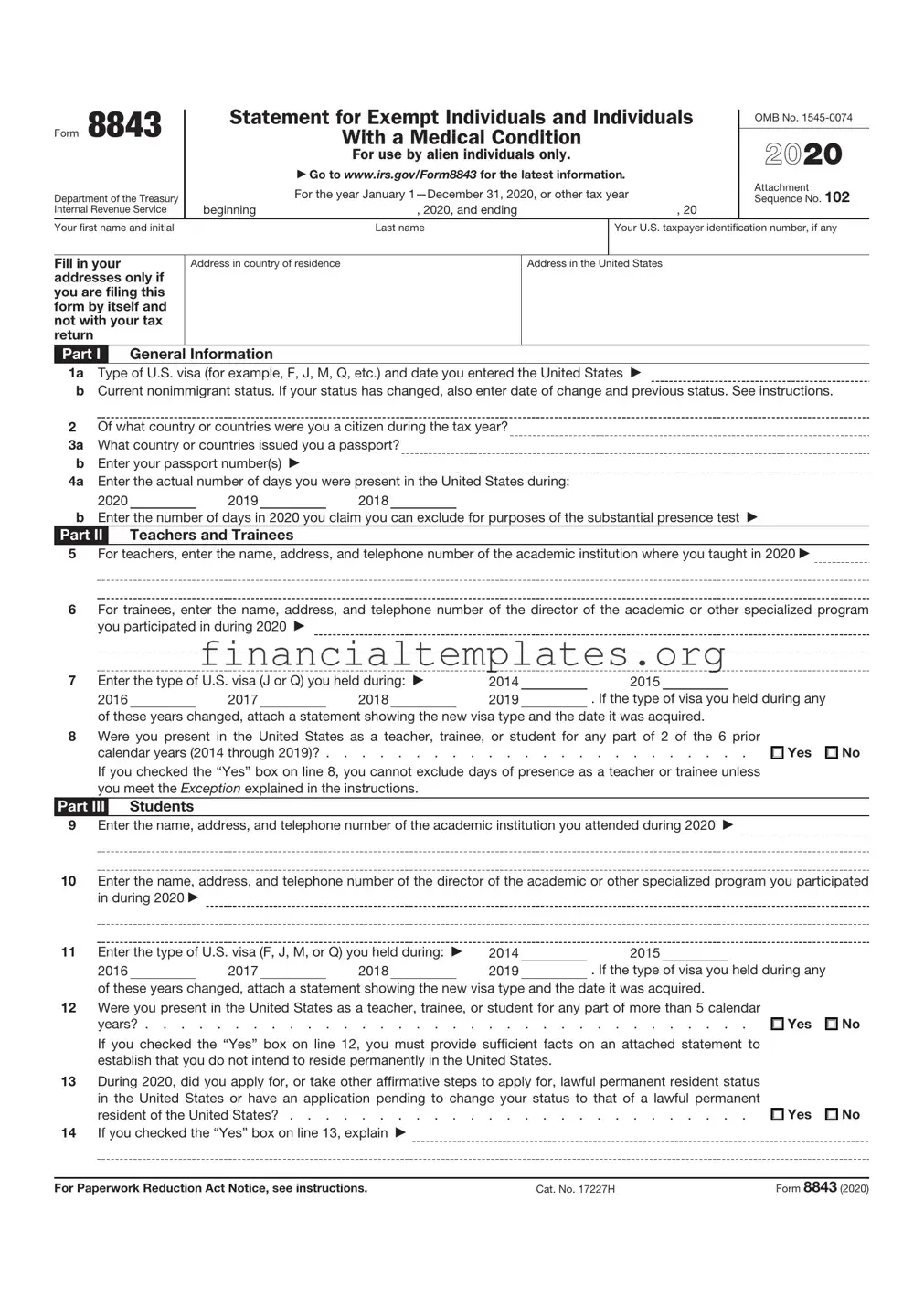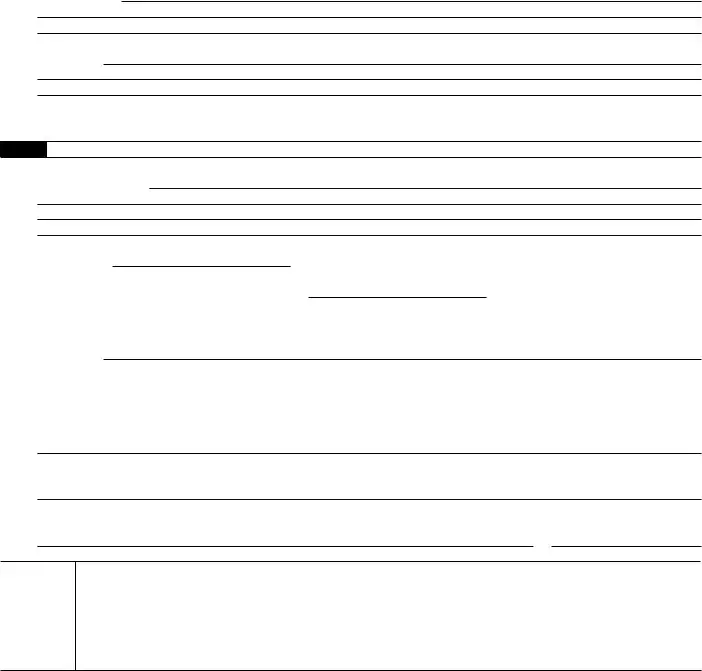Eligible individual. To be considered an eligible individual, you must satisfy the following requirements.
•You were not considered a U.S. resident at the end of 2019.
•You were not a lawful permanent resident (green card holder) at any time in 2020.
•You were present in the United States on each of the days of your COVID-19 emergency period (defined later).
•You did not become a U.S. resident in 2020 due to days of presence in the United States outside of your COVID-19 emergency period.
COVID-19 emergency period. A single period of up to 60 consecutive calendar days you select, starting no earlier than February 1, 2020, but no later than April 1, 2020, during which you were physically present in the United States, but were unable to leave due to travel disruptions.
More information. For more information, including the impact of travel disruptions on treaty benefits, see Rev. Proc. 2020-20, 2020-20 I.R.B. 801, available at www.irs. gov/irb/2020-20_IRB#REV-PROC-2020-20.
30-Day Medical Condition
If you are an alien individual who intended, but was unable, to leave the United States for a continuous period of up to 30 days in 2020 because of a medical condition or medical problem that arose while you were in the United States, you may file Form 8843 without a physician’s statement in Part V to exclude these days of presence in the United States. This exception to the requirement to obtain a physician’s statement in order to claim a medical condition as a basis to exclude days of presence only applies to a single continuous period of up to 30 days, and any additional days in which you were unable to leave the United States due to a medical condition or medical problem that would require a physician’s statement in Part V.
Specific Instructions
Note: If you are claiming the Rev. Proc. 2020-20 Exception or the 30-Day Medical Condition, complete your identifying information at the top of Form 8843, and Part I, as discussed later. Complete Parts II, III, and IV, if applicable. You must also complete Part V, as discussed later.
Part I—General Information
If you are attaching Form 8843 to Form 1040-NR, you aren’t required to complete lines 1a through 4a of Form 8843 if you provide the requested information on the corresponding lines of Form 1040-NR. See Schedule OI of those forms.
In this case, enter “Information provided on Form 1040-NR” on line 1a of Form
8843. Complete line 4b and the rest of Form 8843.
If Form 8843 is filed separately, you must complete all entries on the form.
Line 1b. Enter your current nonimmigrant status, such as that shown on your current Immigration Form I-94, Arrival-Departure Record. If your status has changed while in the United States, enter the date of change and previous status.
Part II—Teachers and Trainees
A teacher or trainee is an individual who is temporarily present in the United States under a “J” or “Q” visa (other than as a student) and who substantially complies with the requirements of the visa.
If you were a teacher or trainee under a “J” or “Q” visa, you are considered to have substantially complied with the visa requirements if you haven’t engaged in activities that are prohibited by U.S. immigration laws that could result in the loss of your “J” or “Q” visa status.
Even if you meet these requirements, you can’t exclude days of presence in 2020 as a teacher or trainee if you were exempt as a teacher, trainee, or student for any part of 2 of the 6 prior calendar years. But see the Exception below.
If you qualify to exclude days of presence as a teacher or trainee, complete Parts I and II of Form 8843. If you have a “Q” visa, complete Part I and only lines 6 through 8 of Part II. On line 6, enter the name, address, and telephone number of the director of the cultural exchange program in which you participated.
Exception. If you were exempt as a teacher, trainee, or student for any part of 2 of the 6 prior calendar years, you can exclude days of presence in 2020 as a teacher or trainee only if all four of the following apply.
1.You were exempt as a teacher, trainee, or student for any part of 3 (or fewer) of the 6 prior calendar years.
2.A foreign employer paid all your compensation during 2020.
3.You were present in the United States as a teacher or trainee in any of the 6 prior years.
4.A foreign employer paid all of your compensation during each of those prior 6 years you were present in the United States as a teacher or trainee.
For more details, see Pub. 519.
If you meet this exception, you must attach information to verify that a foreign employer paid all the compensation you received in 2020 and all prior years that you were present in the United States as a teacher or trainee.
Part III—Students
A student is an individual who is temporarily present in the United States under an “F,” “J,” “M,” or “Q” visa and who substantially complies with the requirements of the visa.
If you were a student under an “F,” “J,” “M,” or “Q” visa, you are considered to have substantially complied with the visa requirements if you haven’t engaged in activities that are prohibited by U.S. immigration laws and could result in the loss of your visa status.
Even if you meet these requirements, you can’t exclude days of presence in 2020 as a student if you were exempt as a teacher, trainee, or student for any part of more than 5 calendar years unless you establish that you don’t intend to reside permanently in the United States. The facts and circumstances to be considered in determining if you have established that you don’t intend to reside permanently in the United States include, but aren’t limited to:
1.Whether you have maintained a closer connection to a foreign country than to the United States (for details, see Pub. 519), and
2.Whether you have taken affirmative steps to change your status from nonimmigrant to lawful permanent resident.
If you qualify to exclude days of presence as a student, complete Parts I and III of Form 8843. If you have a “Q” visa, complete Part I and only lines 10 through 14 of Part III. On line 10, enter the name, address, and telephone number of the director of the cultural exchange program in which you participated.
Part IV—Professional Athletes
A professional athlete is an individual who is temporarily present in the United States to compete in a charitable sports event.
For details on charitable sports events, see Pub. 519.
If you qualify to exclude days of presence as a professional athlete, complete Parts I and IV of Form 8843.
Part V—Individuals With a Medical Condition or Medical Problem
For purposes of the substantial presence test, don’t count the days you intended to leave the United States but couldn’t do so because of a medical condition or medical problem that arose while you were in the United States. Whether you intended to leave the United States on a particular day is determined based on all the facts and circumstances. For more details, see Pub. 519.


